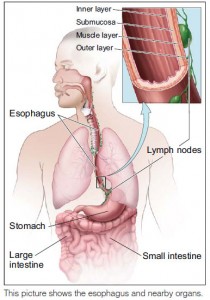Maestro Seiji Ozawa Diagnosed with Cancer
 Maestro Seiji Ozawa, 74, has been diagnosed with esophageal cancer. The world renown conductor, who led the Boston Symphony Orchestra for 29 years, and is currently the chief conductor of the Vienna State Opera, reports that the cancer was detected in an early stage and will take the next 6 month off to undergo treatment. At a press conference, Ozawa said, “As my doctor guaranteed, I will come back by July. In fact, I got sick in time to fulfill my summer schedule.”
Maestro Seiji Ozawa, 74, has been diagnosed with esophageal cancer. The world renown conductor, who led the Boston Symphony Orchestra for 29 years, and is currently the chief conductor of the Vienna State Opera, reports that the cancer was detected in an early stage and will take the next 6 month off to undergo treatment. At a press conference, Ozawa said, “As my doctor guaranteed, I will come back by July. In fact, I got sick in time to fulfill my summer schedule.”
What is the Esophagus?
The esophagus, which is part of the digestive tract, is the section in the chest between the mouth and the stomach. It is about 10 inches long.
The esophagus is a muscular tube and has several layers:
- Inner layer or lining ( mucosa): The lining of the esophagus is moist so that food can pass to the stomach.
- Submucosa: The glands in this layer make mucus. Mucus keeps the esophagus moist.
- Muscle layer: The muscles push the food down to the stomach.
- Outer layer: The outer layer covers the esophagus.

Source: National Cancer Institute
What is Esophageal Cancer?
There are two main types of esophageal cancer. Both types are diagnosed, treated, and managed in similar ways. The types are named for how the cancer cells look under a microscope. Both types begin in cells in the inner lining of the esophagus:
- Adenocarcinoma of the esophagus: This tumor arises from the mucus producing cells in the esophagus. This type is usually found in the lower part of the esophagus, near the stomach. In the United States, adenocarcinoma is the most common type of esophageal cancer. It’s been increasing since the 1970s.
- Squamous cell carcinoma of the esophagus: This tumor arises from flat, thin cells which line the mucosa called squamous cells This type is usually found in the upper part of the esophagus. This type is becoming less common among Americans. Around the world, however, squamous cell carcinoma is the most common type.
Who is at Risk for Esophageal Cancer?
Risk factors for developing esophageal cancer include:
- Smoking
- Heavy drinking
- Damage from acid reflux- when the acidic contents of the stomach back up into the esophagus.
- Barrett’s esophagus- If reflux of stomach acid into the lower esophagus continues for a long time, it can damage the lining of the esophagus. This causes the squamous cells that usually line the esophagus to be replaced with glandular cells. These glandular cells usually look like the cells that line the stomach and the small intestine, and are more resistant to stomach acid. This condition is known as Barrett’s esophagus. People with Barrett’s esophagus are anywhere from 30 to 125 times more likely than people without this condition to develop esophageal cancer.
For more information:
 |
Resounding Health(tm) Esophageal Cancer |
![]()

